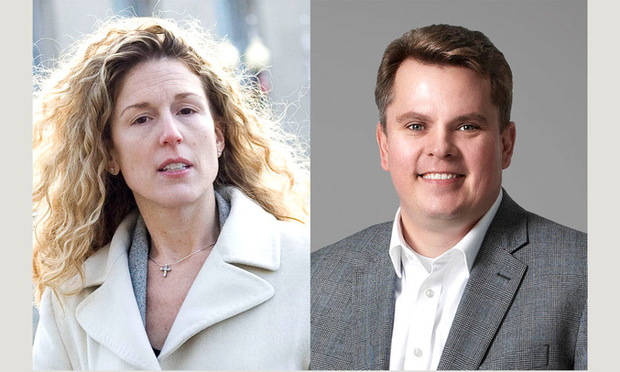Between the Lines: Walmart In-House Lawyers Played Key Roles in Scandal
The documents also paint a picture of top Walmart executives, including its general counsel at the time, who were more concerned with growth than with exploring the red flags around them. At least eight Walmart executives have left the company in the wake of the scandal.
June 21, 2019 at 05:08 PM
5 minute read
 Laura Perkins, left, and Jay Jorgensen, right.
Laura Perkins, left, and Jay Jorgensen, right.
A deep dive into government documents released Thursday surrounding the foreign bribery settlement with Walmart Inc. reveals that in-house lawyers at the company played key roles in both executing bribe schemes and exposing them.
The documents also paint a picture of top Walmart executives, including its general counsel at the time, who were more concerned with growth than with exploring the red flags around them. At least eight Walmart executives have left the company in the wake of the scandal.
Laura Perkins, a partner at Hughes Hubbard & Reed in Washington, D.C., noted that no Walmart executive was charged with wrongdoing. “The papers repeatedly make the point that while red flags may have been known and ignored [by the executives], the actual underlying conduct was not known,” said Perkins, a former assistant chief of the Foreign Corrupt Practices Act unit in the U.S. Department of Justice's criminal division.
The nearly 200 pages of documents include a cease and desist order and a statement of facts from the U.S. Securities and Exchange Commission. From the U.S. Department of Justice came criminal information filed against a Brazilian subsidiary; the subsidiary's plea agreement; the court judgment; a global nonprosecution agreement covering misconduct in Mexico, China, India and Brazil, along with another statement of facts.
Although the documents do not use the names of the in-house lawyers, nor the executives who either supported or ignored them, most of the players have been identified in other stories in Corporate Counsel and elsewhere.
For example, Sergio Cicero Zapata worked for Walmart as an in-house real estate attorney in Mexico from 1991 to 2004. He was the original whistleblower on the Mexico bribery scheme in 2005. That case eventually led Walmart headquarters to probe other foreign subsidiaries in an internal investigation that also found bribery problems in the other three countries.
The DOJ documents refer to Cicero as “Mexico Subsidiary Attorney.” The SEC papers call him “Mexico Subsidiary Lawyer A.” But his detailed story about paying bribes through third-party intermediaries on more than 300 projects is substantially the same in both documents. Cicero's statements implicate both the subsidiary's general counsel and its chief executive in the bribery scheme. As DOJ put it: “Mexico Subsidiary Lawyer A claimed that Mexico Subsidiary Executive A (the CEO), Mexico Subsidiary Internal Auditor, and Mexico Subsidiary Lawyer B (defined as the subsidiary's senior attorney)—who had been named Mexico Subsidiary's compliance officer after Mexico Subsidiary Lawyer A left Mexico Subsidiary—also participated in the scheme.”
Both the CEO and the Mexican general counsel have denied wrongdoing, and both have left Walmart after the bribe scheme was revealed.
While Cicero's descriptions of what the two men did—or didn't do—about the bribes, are damning, so is the government's portrait of the Walmart leadership in Bentonville, Arkansas, at the time.
The papers detail how Cicero reported the bribe scheme to the in-house legal department in Bentonville. The woman who received his whistleblower complaint in 2005 was Maritza Munich, then general counsel of Walmart International, who reported to corporate general counsel Thomas Mars.
Munich did a preliminary investigation into Cicero's allegations, found the red flags and recommended that Walmart hire independent investigators to continue. Mars squelched her recommendation.
Instead Mars assigned any further investigating to the general counsel of the Mexican subsidiary—even though that GC was a target of Cicero's complaint. The Mexican GC wrote a 2006 report stating, “that no evidence existed to substantiate that [the] Mexico subsidiary made unlawful payments to government officials.” Munich eventually resigned.
Mars later became chief administrative officer of Walmart. He left the company in 2013 and has repeatedly declined comment.
In 2012, Walmart brought in Jay Jorgensen as executive vice president and global chief ethics and compliance officer, to help build a state-of-the-art compliance program. Jorgensen, who left last December to become general counsel and chief compliance officer at the South Korean e-commerce company Coupang, was visiting in the U.S. when the Walmart settlement was announced.
He could not speak to what went on at the company prior to 2012. But he said he was part of meetings with the DOJ in which investigators focused on how Walmart's new program would handle whistleblower complaints or red flags.
“They really grilled us,” Jorgensen recalled. “We went through hundreds of pages of material. We had hired more than 2,000 compliance people. In the end they were impressed.”
He said a company can invest millions of dollars in a top compliance program and that's no guarantee that bad things won't happen. “But if you have a professional process, and monitor it and test it, then you can have credibility with the government that you are doing everything you can.”
Hughes Hubbard's Perkins agreed. The lessons for in-house counsel from the Walmart case are simple, she said: “Don't ignore red flags, and focus on the need for due diligence on third parties. That's the big takeaway here.”
Correction: The article incorrectly said Thomas Mars left the general counsel post in 2012, after The New York Times broke the Mexican bribery story. He left the post to become chief administrative officer in 2009.
Read More:
Walmart Agrees to Pay $282M and Hire Louis Freeh as Monitor in FCPA Settlement
How Wal-Mart Avoided a Record Fine but Still Paid Dearly
Wal-Mart FCPA Settlement Offers Big Lessons for GCs About Bribery
This content has been archived. It is available through our partners, LexisNexis® and Bloomberg Law.
To view this content, please continue to their sites.
Not a Lexis Subscriber?
Subscribe Now
Not a Bloomberg Law Subscriber?
Subscribe Now
NOT FOR REPRINT
© 2025 ALM Global, LLC, All Rights Reserved. Request academic re-use from www.copyright.com. All other uses, submit a request to [email protected]. For more information visit Asset & Logo Licensing.
You Might Like
View All

Starbucks Hands New CLO Hefty Raise, Says He Fosters 'Environment of Courage and Joy'


Riding High, Texas Roadhouse Gives Legal Chief 3-year Contract Extension,15% Salary Boost
2 minute readTrending Stories
- 1'Incredibly Complicated'? Antitrust Litigators Identify Pros and Cons of Proposed One Agency Act
- 2'A Warning Shot to Board Rooms': DOJ Decision to Fight $14B Tech Merger May Be Bad Omen for Industry
- 3Securities Action Targeting Polestar Alleges Mistakes in SEC Filings
- 4Conspiracy Suits Against Quinn Emanuel, Roc Nation Moved to Federal District Court
- 5'Knowledge of Mismatch:' Fed Judge Offers Guidance on How to Hold Banks Accountable for Erroneous Transfers
Who Got The Work
J. Brugh Lower of Gibbons has entered an appearance for industrial equipment supplier Devco Corporation in a pending trademark infringement lawsuit. The suit, accusing the defendant of selling knock-off Graco products, was filed Dec. 18 in New Jersey District Court by Rivkin Radler on behalf of Graco Inc. and Graco Minnesota. The case, assigned to U.S. District Judge Zahid N. Quraishi, is 3:24-cv-11294, Graco Inc. et al v. Devco Corporation.
Who Got The Work
Rebecca Maller-Stein and Kent A. Yalowitz of Arnold & Porter Kaye Scholer have entered their appearances for Hanaco Venture Capital and its executives, Lior Prosor and David Frankel, in a pending securities lawsuit. The action, filed on Dec. 24 in New York Southern District Court by Zell, Aron & Co. on behalf of Goldeneye Advisors, accuses the defendants of negligently and fraudulently managing the plaintiff's $1 million investment. The case, assigned to U.S. District Judge Vernon S. Broderick, is 1:24-cv-09918, Goldeneye Advisors, LLC v. Hanaco Venture Capital, Ltd. et al.
Who Got The Work
Attorneys from A&O Shearman has stepped in as defense counsel for Toronto-Dominion Bank and other defendants in a pending securities class action. The suit, filed Dec. 11 in New York Southern District Court by Bleichmar Fonti & Auld, accuses the defendants of concealing the bank's 'pervasive' deficiencies in regards to its compliance with the Bank Secrecy Act and the quality of its anti-money laundering controls. The case, assigned to U.S. District Judge Arun Subramanian, is 1:24-cv-09445, Gonzalez v. The Toronto-Dominion Bank et al.
Who Got The Work
Crown Castle International, a Pennsylvania company providing shared communications infrastructure, has turned to Luke D. Wolf of Gordon Rees Scully Mansukhani to fend off a pending breach-of-contract lawsuit. The court action, filed Nov. 25 in Michigan Eastern District Court by Hooper Hathaway PC on behalf of The Town Residences LLC, accuses Crown Castle of failing to transfer approximately $30,000 in utility payments from T-Mobile in breach of a roof-top lease and assignment agreement. The case, assigned to U.S. District Judge Susan K. Declercq, is 2:24-cv-13131, The Town Residences LLC v. T-Mobile US, Inc. et al.
Who Got The Work
Wilfred P. Coronato and Daniel M. Schwartz of McCarter & English have stepped in as defense counsel to Electrolux Home Products Inc. in a pending product liability lawsuit. The court action, filed Nov. 26 in New York Eastern District Court by Poulos Lopiccolo PC and Nagel Rice LLP on behalf of David Stern, alleges that the defendant's refrigerators’ drawers and shelving repeatedly break and fall apart within months after purchase. The case, assigned to U.S. District Judge Joan M. Azrack, is 2:24-cv-08204, Stern v. Electrolux Home Products, Inc.
Featured Firms
Law Offices of Gary Martin Hays & Associates, P.C.
(470) 294-1674
Law Offices of Mark E. Salomone
(857) 444-6468
Smith & Hassler
(713) 739-1250






